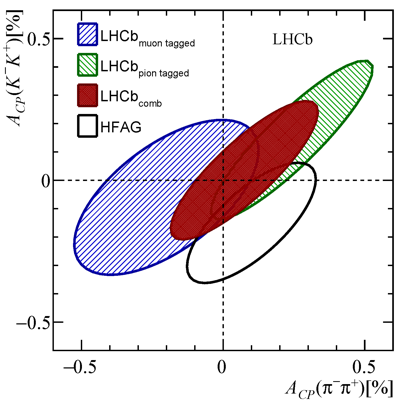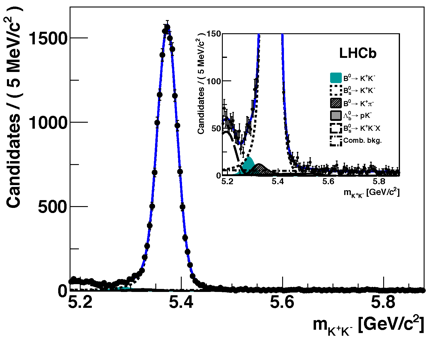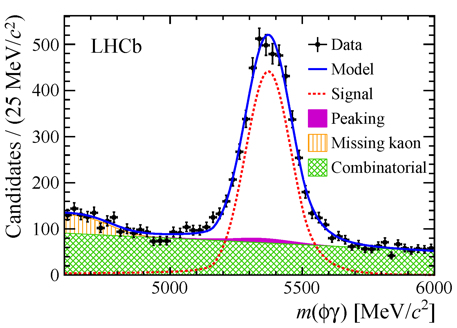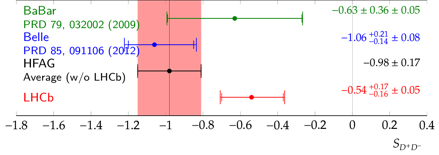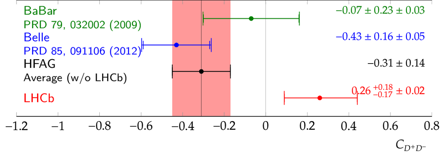The LHCb collaboration presented this week new results at the 38th International Conference on High Energy Physics, ICHEP, which is taking place place at Chicago. A few selected items are listed below.
(1) Measurement of the b-quark production cross-section in pp collisions at 7 and 13 TeV. The probability of b- and b-quark production (cross-section) in proton-proton collisions can be calculated in the framework of the theory of strong interactions, quantum chromodynamics (QCD). Sizeable uncertainties exist in the absolute predictions, but they are strongly reduced in the ratio R13/7 of calculations performed for 13 TeV and 7 TeV. The image shows a comparison of these calculations with the results of the LHCb measurement as a function of the variable, pseudo-rapidity η related to the b-hadron production angle θ measured with respect to the direction of incoming proton beams, η=-ln(tan(θ/2)). This image is different from that presented at the conference, as described in the erratum to the corresponding paper. The ratio R13/7 is 2.00 ± 0.02 ± 0.26 and is in agreement with theoretical expectations over the whole η range under study.
(2) Most precise CP violation measurement of a single decay of charmed particles. The measurements of D0 mesons decays into pairs of K+ and K– mesons was reported. This measurement is interesting since charmed D-meson decays are suitable for probing CP violation in the up-type quark sector. CP violation is related to the difference between the properties of matter and antimatter. It is measured here as the asymmetry parameter ACP, which differs from zero if and only if the probability of the D0 meson to decay into a K+K– pair differs from that of the D0 meson. Recent studies of CP violation in weak decays of D mesons show a good consistency with the hypothesis of CP symmetry so far, in agreement with the expectation of the Standard Model, which predicts very small violation in the charmed system. This is to be contrasted with K and B meson decays, where CP violation is well established, again in broad agreement with the predictions of the Standard Model. By combining the results presented at the conference with previously reported the most precise determination of CP violation in the D0 decays into K+ and K– as well as into π+ and π– meson pairs from a single experiment have been obtained. The image summarises the current situation. The LHCb results presented at Chicago are shown as a dashed green ellipse. The D0 and D0 decays were identified using a so-called “pion tagged” technique. The dashed blue ellipse shows previous results which used a “muon tagged” technique and the red one represents the combination of both measurements. The black ellipse shows a world combination made by the Heavy Flavor Averaging Group, HFAG, which includes the results of other experiments as well as older LHCb results. As apparent from the image there is no evidence for CP violation yet.
(3) Rarest fully hadronic B decay mode ever observed. The B0-meson decay into a K+K– meson pair is observed for the first time ever with a significance of more than 5 standard deviations. This decay was searched for in the past for a long time by other experiments. The left image below shows a contribution of this decay to the the K+K– invariant mass spectrum. It occurs at a rate of less than 1 time in 10 million B0 decays. This result will help to refine the QCD calculations of the dynamics governing the decays of heavy-flavoured hadrons. The understanding of this dynamics is a fundamental ingredient in the search for new particles and interactions beyond those included in the Standard Model.
(4) First attempt to probe anomalous photon polarisation in Bs to φγ decays. The b-quark to s-quark transition accompanied by a photon γ is considered as a very interesting process in which signs of new physics could show up. New physics models often predict a different value of photon polarisation than that predicted by the Standard Model. LHCb physicists already succeeded to observe a non-vanishing value of the γ polarisation for the first time in B+→K+π–π+ γ decays (see 28 February 2014 news for introduction and the measurement details) and have probed its nature in B0→K*e+e– decays. This week the collaboration reported the first measurement of the photon polarisation in Bs to φγ decays. The right image above shows the φγ invariant mass spectrum with a clear accumulation of events at the Bs mass. The lifetimes of the mesons in this sample have been analysed and from this study information has been extracted on the photon polarisation. The result is consistent with the Standard Model prediction within 2 standard deviations.
(5) Measurement of time-dependent CP violation in B0 to D+D– decays. The Standard Model angle β of the unitarity triangle is usually measured in the decays of the B0 and B0 mesons to J/ψ and Ks0 mesons, see 3 March 2015 news. The measurement of β in the decay of the B0 meson into D+D– mesons is relevant as it enables higher order Standard Model and new physics contributions to be probed and constrained. LHCb reported the measurement of the, so called, C and S observables. The results are consistent with the Standard Model expectation, which in the absence of these additional contributions, are S of around -0.75(-sin2β) and C = 0. The images below show the comparison of the LHCb results with previous measurements by the BaBar and Belle collaborations.
See more details in the LHCb ICHEP presentations linked from the section titles in italic and in the LHCb papers: (1), (2), (3), (4) and (5). Click the images for higher resolution.


